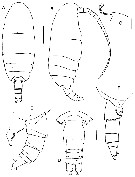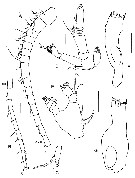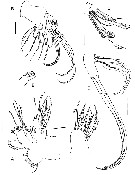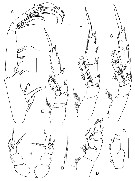|
|
 |
|
Calanoida ( Order ) |
|
|
|
Clausocalanoidea ( Superfamily ) |
|
|
|
Diaixidae ( Family ) |
|
|
|
Vensiasa ( Genus ) |
|
|
| |
Vensiasa incerta Markhaseva, 2015 (F) | |
| | | | | | | Ref.: | | | Markhaseva, 2015 (p.185, Descr.F, figs.F) |  Issued from : E.L. Markhaseva in Proc. Zool. Inst. RAS, 2015, 319 (2). [p.186, Fig.1]. Female (from tropical S Atlantic): A-B, habitus (dorsal and lateral, respectively); C, rostrum (lateral); D, posterior prosome and urosome (dorsal); E-F, same (lateral). Scale bars: A-B = 0. 5 mm; C-F = 0.1 mm. A-C, E: holotype; D: paratype; F, additional female specimen from 36°00.61'S, 49°01.55'W. Nota : Prosome 3.5-4.1 times as long as urosome. - Rostrum as a poorlydeveloped plate with 2 filaments. - Suture between cephalosome and pediger 1 incompletely visible (lateral and dorsal views) and between pedigers 4 and 5 sometimes incomplete in lateral views. - Posterior corners triangular in dorsal view, as rounded lobes in lateral view. - Urosome 4 somites. - Right posterior border og genital double-somite undulated or not. - Spermathecae of moderate size, narrow, upturned anteriorly. - Caudal ramus with 4 terminal plus 1 small dorsolateral and 1 small ventral setae each.
|
 Issued from : E.L. Markhaseva in Proc. Zool. Inst. RAS, 2015, 319 (2). [p.187, Fig.2]. Female: A, A1 (ancestral segments I-XVIII; B, A1 (ancestral segments XIX-XXVIII); C, A1 (ancestral segments XXVII-XXVIII); D, A2; E, Md palp; F-G, Md gnathobase. Scale bars = 0.1 mm. A-C, E: holotype; D, F-G: paratype from 00°42.7'S, 05°31.2'W. Nota : A1 nearly as long as prosome, 24-segmented. - A2 coxa with 1 seta ; basis with 2 setae ; endopodal segment 1 with 1 seta, endopodal segment 2 with 13 or 15 setae ; exopod 8-segmented, setal formula 0, 0-0-1, 1, 1, 1, 1, 1, 3. Md gnathobase with 7-8 cutting teeth ; exopod 5-segmented with 1, 1, 1, 1and 2 setae ; endopod segment1 with 3 setae, 2 nd with 9 setae ; basis with 3 setae. Nota: Mx1 : praecoxal arthrite with 9 terminal spines, 2 posterior setae and 1 anterior seta ; coxal endite with 3 setae, coxal epopodite with 9 setae (sometimes 8) ; proximal basal endite with 3 setae, distal basal endite with 3 setae ; endopod with 5 setae, exopod with 8 setae. - Mx2 : praecoxal endite bearing 5 setae and attenuation, coxal with 3 setae ; proximal basal endite with 3 setae ; distal basal endite with 3 setae, 2 setae equal in length and curved distally ; enditic-like lobe of proximal endopodal segment with 4 setae, 2 setae lo,g, equal in length and curved distally and 2 setae short, sensory, worl-like. Endopod with 8 sensory setae (6w + 2br), 3 terminal worm-like setae long, 3 proximal worm-like setae short and very thin and 2 brush-like setae (1 thick with brush well developed and 1 thin with poorly developed brush). -Mxp : syncoxa with 1 sclerotized seta on proximal praecoxal endite , 2 sclerotized setae on middle endite, and 3 setae on distal praecoxal endite, distalmost poorly sclerotized terminally ; coxal endite with 3 setae. Basis with 3 medial setae plus 2 setae distally ; endopod 5-segmented with 4, 4, 3, 3+1 and 4 setae.
|
 Issued from : E.L. Markhaseva in Proc. Zool. Inst. RAS, 2015, 319 (2). [p.188, Fig.3]. Female: A, Mx1 (arrow marks praecoxal arthrite, other position); B, Mx2; C, Mx2 endopod (arrow marks head of a thin brush-like seta); D, Mx2 (endopod and enditic-like lobe of proximal endopodal segment; E, Mx2 praecoxal endite. Scale bars = 0.1 mm. A-C: paratype; D-E = holopype. Nota: Mx1 : praecoxal arthrite with 9 terminal spines, 2 posterior setae and 1 anterior seta ; coxal endite with 3 setae, coxal epopodite with 9 setae (sometimes 8) ; proximal basal endite with 3 setae, distal basal endite with 3 setae ; endopod with 5 setae, exopod with 8 setae. - Mx2 : praecoxal endite bearing 5 setae and attenuation, coxal with 3 setae ; proximal basal endite with 3 setae ; distal basal endite with 3 setae, 2 setae equal in length and curved distally ; enditic-like lobe of proximal endopodal segment with 4 setae, 2 setae lo,g, equal in length and curved distally and 2 setae short, sensory, worl-like. Endopod with 8 sensory setae (6w + 2br), 3 terminal worm-like setae long, 3 proximal worm-like setae short and very thin and 2 brush-like setae (1 thick with brush well developed and 1 thin with poorly developed brush).
|
 Issued from : E.L. Markhaseva in Proc. Zool. Inst. RAS, 2015, 319 (2). [p.189, Fig.4]. Female: A, Mxp; B, P1; C, P1 endopod; D, P1 lateral and terminal spines of exopod segment 3; E, P2; F, P3; G, P4; H, P5. Scale bars = 0.1 mm. Nota : Mxp : syncoxa with 1 sclerotized seta on proximal praecoxal endite , 2 sclerotized setae on middle endite, and 3 setae on distal praecoxal endite, distalmost poorly sclerotized terminally ; coxal endite with 3 setae. Basis with 3 medial setae plus 2 setae distally ; endopod 5-segmented with 4, 4, 3, 3+1 and 4 setae. - P5 uniramous, symmetrical, 3-segmented with single medial spine, 1 lateralspine-like, partly articulated extension and 2 spine-like unarticulated and unequal extensions terminally.
| | | | | NZ: | 1 | | |
|
Distribution map of Vensiasa incerta by geographical zones
|
| | | | Loc: | | | S. Atlant.
Type locality: 0°01.2' S, 2°28.7' W. | | | | N: | 1 | | | | Lg.: | | | (1186) F: 2,75-3,1; {F: 2,75-3,10} | | | | Rem.: | Above sea bed at depth 4605-4585 m; 5058 m and 5140 m. | | | Last update : 05/01/2017 | |
|
|
 Any use of this site for a publication will be mentioned with the following reference : Any use of this site for a publication will be mentioned with the following reference :
Razouls C., Desreumaux N., Kouwenberg J. and de Bovée F., 2005-2025. - Biodiversity of Marine Planktonic Copepods (morphology, geographical distribution and biological data). Sorbonne University, CNRS. Available at http://copepodes.obs-banyuls.fr/en [Accessed October 16, 2025] © copyright 2005-2025 Sorbonne University, CNRS
|
|
 |
 |







